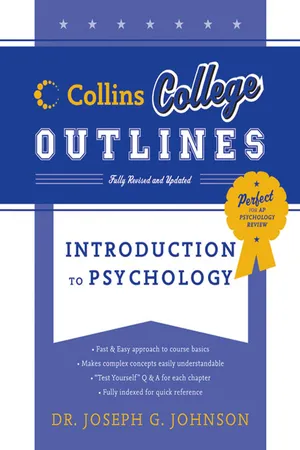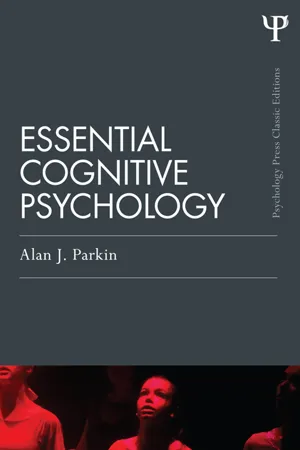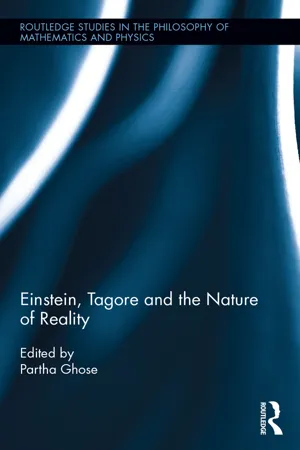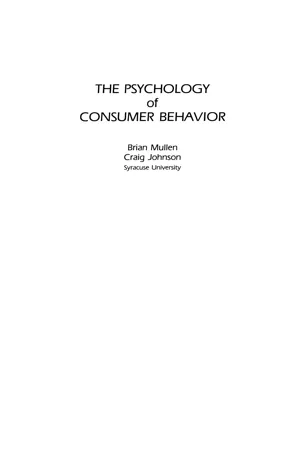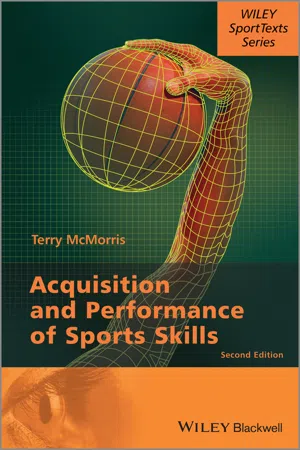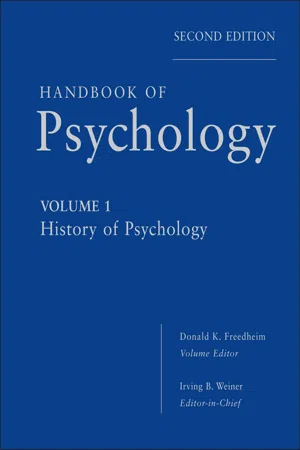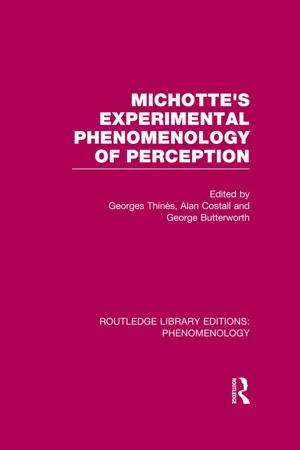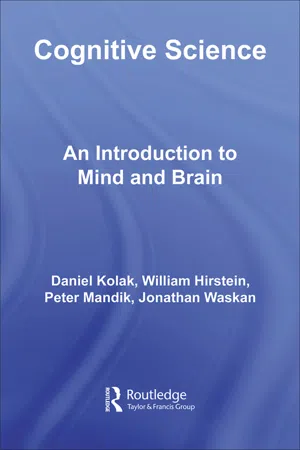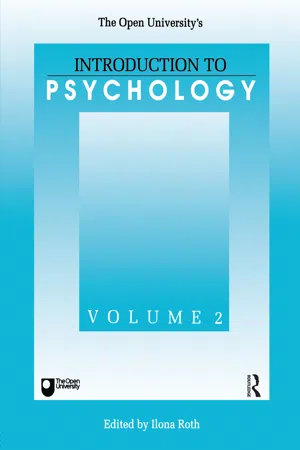Psychology
Perception
Perception refers to the process by which individuals interpret and make sense of sensory information from the environment. It involves organizing, identifying, and interpreting sensory stimuli to create a meaningful understanding of the world. Perception is influenced by individual experiences, expectations, and cognitive processes, and it plays a crucial role in shaping behavior and decision-making.
Written by Perlego with AI-assistance
Related key terms
11 Key excerpts on "Perception"
- eBook - ePub
Sports Psychology
Concepts and Applications
- S. K. Mangal, Shubhra Mangal(Authors)
- 2023(Publication Date)
- Routledge India(Publisher)
E.G. Boring et al. (1948:10): “Perception is the first event in the chain which leads from the stimulus to action.”Charles G. Morris (1979 :325): “All the processes involved in creating meaningful patterns out of a jumble of sensory impressions fall under the general category of Perception.”Edmund Fantino and G.S. Reynolds (1975:262): “Perception is the organizing process by which we interpret our sensory input.”Otello Desiderato et al. (1976:128): “Perception is the experience of objects, events or relationships obtained by extracting information from and interpreting sensations.”R.E. Silverman (1979 :123): “Perception is an individual’s awareness aspect of behaviour, for it is the way each person processes the raw data he or she receives from the environment, into meaningful patterns.”PerceptionPerception is a highly individualised psychological process that helps us organise and interpret the complex patterns of sensory stimulation to provide the meaning necessary to initiate our behavioural response.The Nature and Characteristics of Perception
A close analysis of the definitions cited here help us draw the following conclusions about the nature and characteristics of the term Perception.- Perception is a process: Perception is essentially a process rather than a product or the outcome of some psychological phenomenon. If we talk in terms of the systems approach, then, sensory impressions, gathered through our sensory organs, may be termed input. The way in which we finally behave or react to this gathered information may be considered output. Perception provides the necessary link in terms of process for converting input into output by organising and interpreting the sensory impressions.
- Perception is the information extractor:
- eBook - ePub
- Ann L. Weber, Joseph Johnson(Authors)
- 2011(Publication Date)
- Collins Reference(Publisher)
CHAPTER 6Perception
P erception is usually taken to mean the final, organized, and meaningful experience of sensory information. The difference between sensation and Perception is one of degree of understanding. Sensation (from a Latin word meaning “to feel”) involves the neural stimulation of sensory systems by physical changes, as we saw in Chapter 5. Perception (from the Latin per or “thorough” and capio or “grasp”) involves recognizing the meaning of what has been sensed. Basically, sensation is detecting a stimulus, whereas Perception is recognizing a stimulus. That is, when one senses a stimulus, one is aware of it, but when one perceives that stimulus, one understands what it is.STUDYING PerceptionThe study of Perception has been guided by different approaches to exactly what the nature of Perception is. To a large degree, the study of Perception has also been defined by the formal quantitative framework used to analyze perceptual performance. These concepts are introduced here to lay the foundation for the remainder of the chapter.Approaches to PerceptionThere are three primary approaches that describe psychologists who study Perception. The ecological approach, founded by James J. Gibson (1904–1979), focuses on the interactions with the environment, in particular how we perceive the cues in the environment that help us to perform specific actions. The constructivist approach is mainly concerned with perceptual inference, or how we use incomplete sensory information to form mental representations. These approaches have contributed a great deal to the more recent computational approach, which attempts to understand the exact computations that a perceptual system performs.Psychophysics RevisitedWe discuss a bit about the historical contributions of psychophysics in Chapter 1 and the application of psychophysics to sensation in Chapter 5. Classical psychophysical studies have examined absolute thresholds - eBook - ePub
- Alan J. Parkin(Author)
- 2014(Publication Date)
- Psychology Press(Publisher)
2 Visual PerceptionWhen I was a student I remember attending a lecture about the human visual system. Midway through the lecture a visiting professor stood and walked to the podium. Addressing the speaker he said, “Look, I can see, I’ve walked up here, what more is there to know?” This was a profoundly ignorant statement which totally failed to appreciate the scientific challenge posed by the study of Perception—in this case the visual system. The things around us do not automatically indicate to us what they are; our Perception of the world is built up by internal processes which operate on an initial input that is far removed from what our sense organs initially register. Vision, for example, begins with a two-dimensional image on the retina but ends up as a three-dimensional scene in which there is depth, colour, movement, and so on. Similarly, hearing begins with the mechanical stimulation of cochlea hair cells by sound waves but what we hear is sufficient to allow us to appreciate the complex sounds of continuous speech.How then do we perceive the world? The prevailing view is to consider the various forms of Perception as instances of an information processing system. It is proposed that Perception begins with various analyses of the initial sensation which become progressively more complex until a percept is formed. A percept is the internal representation derived from the initial pattern of stimulation and it is this that serves as the basis for subsequent identification processes, i.e. determining what an object looks like, sounds like, smells like, and so on.Forms of perceptual processWe have, as you all know, five senses—vision, hearing, touch, smell and taste. Cognitive psychologists have been very uneven in the time they have devoted to the study of our senses. Most work has been carried out on our visual system because of the dominant role it plays in communication. Next comes hearing, followed by touch, smell and taste. Research into hearing has been quite substantial owing to the need to understand speech Perception but the other three senses have received relatively little attention. However, research into touch (often known as haptic Perception) has received considerable impetus from its relevance to communication aids for the blind. Smell and taste, although subject to some investigation within cognitive psychology, have been of more interest to physiologists. In this book we will be primarily concerned with visual Perception (this chapter) and with hearing in relation to speech Perception (Chapter 10 - eBook - ePub
- Alan J. Parkin(Author)
- 2013(Publication Date)
- Psychology Press(Publisher)
2 VISUAL PerceptionWhen I was a student I remember attending a lecture about the human visual system. Midway through the lecture a visiting professor stood and walked to the podium. Addressing the speaker he said, ‘Look, I can see, I’ve walked up here, what more is there to know?’ This was a profoundly ignorant statement which totally failed to appreciate the scientific challenge posed by the study of Perception—in this case the visual system. The things around us do not automatically indicate to us what they are; our Perception of the world is built up by internal processes which operate on an initial input that is far removed from what our sense organs initially register. Vision, for example, begins with a two-dimensional image on the retina but ends up as a three-dimensional scene in which there is depth, colour, movement, and so on. Similarly, hearing begins with the mechanical stimulation of cochlear hair cells by sound waves but what we hear is sufficient to allow us to appreciate the complex sounds of continuous speech.How then do we perceive the world? The prevailing view is to consider the various forms of Perception as instances of an information processing system. It is proposed that Perception begins with various analyses of the initial sensation which become progressively more complex until a percept is formed. A percept is the internal representation derived from the initial pattern of stimulation and it is this that serves as the basis for subsequent identification processes, i.e. determining what an object looks like, sounds like, smells like, and so on.Forms of perceptual processWe have, as you all know, five senses—vision, hearing, touch, smell, and taste. Cognitive psychologists have been very uneven in the time they have devoted to the study of our senses. Most work has been carried out on our visual system because of the dominant role it plays in communication. Next comes hearing, followed by touch, smell, and taste. Research into hearing has been quite substantial owing to the need to understand speech Perception but the other three senses have received relatively little attention. However, research into touch (often known as haptic Perception) has received considerable impetus from its relevance to communication aids for the blind. Smell and taste, although subject to some investigation within cognitive psychology, have been of more interest to physiologists. In this book we will be primarily concerned with visual Perception (this chapter) and with hearing in relation to speech Perception (Chapter 10 - eBook - ePub
- Partha Ghose(Author)
- 2016(Publication Date)
- Routledge(Publisher)
9 Cognitive constraints on the Perception of realityAvi ChaudhuriThe eye sees only what the mind is prepared to comprehend. Robertson DaviesOur Perception of the physical environment requires two very different processes. The first step is the acquisition of sensory signals through the various receptors that have evolved over eons, such as the eyes, ears, nose and so on. Psychologists refer to the sequential analysis of sensory signals as bottom-up processing. A key element in this construction is that sensory systems are engaged in information processing of only environmental signals and do so by piecing together small chunks of the stimulus to eventually create a Perception of the stimulus. Sensory processing, according to this theory, begins with the stimulus itself and is then processed in a direct manner through successive stages.1 One school of thinking contends that all the necessary information required by our brain can be recovered from the environment to produce a mental representation. Perhaps Einstein would have belonged to that school.British psychologist Richard Gregory proposed a completely different theory of perceptual processing. According to Gregory, sensory Perception is not just the mere outcome of sequential bottom-up processing, but rather depends strongly on the past experiences, contextual information, inference, knowledge, mental state and even the cultural background of the individual.2 Thus, Perception is the outcome of top-down processing in which cognitive factors play key constructive roles in generating perceptual awareness. Unlike the direct and automated manner of bottom-up processing, the top-down theory proposes that Perceptions are constructed in an indirect manner. The brain can only make sense of the incoming sensory signal by relying on past experience and prior knowledge. The constructivist - eBook - ePub
- Brian Mullen, Craig Johnson(Authors)
- 2013(Publication Date)
- Psychology Press(Publisher)
2 PerceptionP erception is defined as the psychological processing of information received by the senses. Our emphasis in this chapter is on the process by which the consumer becomes aware of the product. Often, Perception is used to refer to the content of the consumer’s beliefs about a product; for example, it is sometimes said that an advertisement led the consumer to develop a favorable Perception of the product. This use of the term Perception is really inappropriate, and refers to processes we consider later when we discuss cognition and memory in chapter 3 .First, we examine some of the approaches to the measurement of Perception. Next, we examine the characteristics of the stimulus situation that affect the individual’s awareness of the product and product characteristics. Note that this approach treats Perception as a consequent of events occurring in the stimulus situation. Next, we consider the characteristics of the human perceptual process that affect the individual’s awareness of the product. Following this, we consider the effects of other internal processes on the individual’s awareness of the product. Finally, we examine the fascinating and complicated notion of subliminal Perception. Bear in mind that our task in this chapter is to understand how consumers become aware of a given product.MEASUREMENT OF AWARENESSThere have been a variety of approaches taken to the measurement of awareness. The most common approach has been to measure some aspect of retention (i.e., the persistence of an experience during an interval of no practice). Retention is more directly a measure of memory. However, it is reasoned that if the person remembers information about the product, he or she must have perceived that information. This raises the question of the accuracy of the retention that is supposed to indicate Perception.Marder and David (1961) demonstrated that subject recognition of information presented in commercial advertisements was surprisingly inaccurate. In their procedure, subjects were shown incomplete advertisements that had some combination of illustration, headline, cartoons, and three sections of copy. Later they were presented with the complete advertisement and asked to indicate whether they recognized portions of this complete advertisement (parts of which they had never seen before). For example, 35% of the subjects in one group reported having seen the headline before (when in fact their initial advertisement had shown no headline). Similarly, 24% of the subjects in another group reported having seen the cartoons before (when in fact their initial advertisement had shown no cartoons). Apparently, subjects in these groups were “projecting” into their memory of the advertisements those elements of the final test advertisement that seemed like they might have been in the original advertisement. This type of research suggests that relying on measures of consumers’ retention may tell us about things other than awareness of the product (such as distortions in memory processes: see chapter 3 - eBook - ePub
- Terry McMorris(Author)
- 2014(Publication Date)
- Wiley(Publisher)
The organization, integration and interpretation of sensory information is thought to take place primarily in the prefrontal cortex, but it draws upon the sensory information held in the specific sensory areas of the cortex and information from LTM contained in several areas of the brain. It should, therefore, be of no surprise to find that fMRI and PET studies have shown considerable activation of the prefrontal cortex during perceptual tasks. The parietal cortex has also been shown to play a role in Perception and is particularly active in tasks where the individual switches attention for one part of the display to another, for example, a defender in hockey switching between attending to her/his immediate opponent and the runs of other attackers.Definition of Perception
Based on the above, we can define Perception, according to information processing theory, as being the organization, interpretation and integration of sensory information. Kerr (1982) provides a similar definition but includes the word ‘conscious’. Although information processing theorists would argue that, most of the time, Perception is a conscious process, recent research on learning and anticipation has shown that it can take place at a subconscious level.Signal detection theory
As information processing theorists claim that Perception is inferred, a number of theories have been developed to explain different aspects of the cognitive processes taking place. One of the first theories was Swets’ (1964; Swets and Green, 1964) signal detection theory. Swets realized that people live in an environment that is full of sensory information. He reckoned that the individual receives over 100 000 signals per second. These may be signals from the environment and/or from within the person themselves. Sport provides many examples of this and the problems it can cause. Think of a tennis player about to serve in a game on Centre Court at Wimbledon. What kinds of signals do you think the player will be receiving visually and auditorally? What kinds of internal signals might the player be receiving: e.g. will I win, will I play well? The problem facing Swets was how to explain how anyone can recognize relevant information against this background of signals, which he termed ‘noise - eBook - ePub
- (Author)
- 2012(Publication Date)
- Wiley(Publisher)
cognition, as used to label a very active field of inquiry in contemporary psychology, is itself quite old. It was first used by St. Thomas Aquinas when he divided the study of behavior into two broad divisions: cognition, meaning how we know the world, and affect, which was meant to encompass feelings and emotions. Today's definition of cognition is equally as broad as that of Aquinas. Although many investigators use the term to refer to memory, association, concept formation, language, and problem solving (all of which simply take the act of Perception for granted), other investigators include the processes of attention and the conscious representation and interpretation of stimuli as part of the cognitive process and some even include the study of consciousness itself. At the very least, cognitive theories of Perception attempt to integrate memory and reasoning processes into the perceptual act.All of these viewpoints suggest that reasoning processes, learning and memory can add to the perceptual experience at any moment, and that there is much more to Perception than is available in the stimulus array. There is, however, one theoretical approach that harkens back to the early sensist approaches and includes a relatively emphatic denial of contributions from reason or intellect. This position was offered by James J. Gibson (1904–1979) and is called direct Perception (e.g., Gibson, 1979). Like the early sensist viewpoints, it begins with the premise that all the information needed to form the conscious percept is available in the stimuli that reach our receptors. For example, even though the image in our eye is continually changing, there are specific aspects of the stimulation produced by any particular object or environmental situation, which are invariant predictors of certain properties (e.g., the actual size, shape, or distance of the object being viewed). These perceptual invariants are fixed properties of the stimulus even though the observer may be moving or changing viewpoints, causing continuous changes in the optical image that reaches the eye. Although this information may be subtle, it is automatically extracted by the perceptual system because it is relevant to survival. Invariants provide information about affordances, - Georges Thinés, Alan Costall, George Butterworth, Georges Thinés, Alan Costall, George Butterworth(Authors)
- 2013(Publication Date)
- Routledge(Publisher)
In order to define the topic of the present address, I shall begin by drawing a perfectly straightforward distinction between the three ways in which we obtain information about the physical world including our own bodies. The first means is through concrete, particular, perceptual events occurring at moments in our lives that are not only under the influence of stimulus systems acting on our sensory organs but are directly linked to them. Through these events in their various aspects (sensory, intellectual, affective …) we come to know not only objects, processes, or groups of objects or processes, but even complex spatio-temporal situations; and these events are the basis of all the knowledge that we acquire about the physical world. This is the most common sense of the term Perception, and though unfortunately it is not exclusive, it is the one we will be adopting in this discussion. The events we are concerned with here are created in a relatively isolated way under artificial laboratory conditions; they are the subject not only of research on “Perception” within psychophysics but also of more complicated studies on the influence of past experience, attitudes, motivations, personality, and so on.In real life, however, Perception does not occur in isolation (this idea is just a fiction sustained within the laboratory). Normally, our sense organs are engaged by a flood of stimulation in continual transformation as the result of changes happening in the external world or from our own actions and movements. Such stimulation provides an untold amount of perceptual data. Although when considered in isolation they might seem like a succession of fleeting events, they are in fact the basis of the ceaseless organization of our own activity. As the result of our own personal experience, we continually create and revise the way we conceive of the world and the laws that control it. No matter how we consider the nature of thought itself, it is obvious that the elaboration of such limitless perceptual data—by comparison, relation, analysis, abstraction, generalization, inference etc.—enormously extends the scope of our knowledge; it allows us to go beyond direct perceptual knowledge in so far as understanding and explanation surpass mere evidence.- eBook - ePub
Cognitive Science
An Introduction to Mind and Brain
- Daniel Kolak, William Hirstein, Peter Mandik, Jonathan Waskan(Authors)
- 2006(Publication Date)
- Routledge(Publisher)
The reason feedback is such an important concept is that investigating Perception in our own case quickly reveals that the notion that we simply receive input from the surrounding environment and thereby “see” it is grossly antiquated. Consider, for instance, what happens when you spot a coin on the ground and reach to pick it up. You perceive a smooth motion in which your hand reaches for the coin and picks it up. But what appears phenomenally as a smooth legato motion is, in reality, a staccato: the body makes a rapid-fire series of muscular adjustments, aiming at the target, overshooting, undershooting, back and forth in a complex feedback between the perceptual representational system in the brain and the motor controls that move and adjust the muscles accordingly to fit both the input data and the phenomenal events being observed in the representational manifold inside the brain. This complex neuroanatomical process involves the eyes, the optic nerves, and many different parts of the brain, all of which must be coordinated to achieve the simple result of picking up a coin. One of the biggest and most difficult questions to answer about human Perception is how these separate functions get coordinated. Studying machine Perception allows us to try to understand this piecemeal, one component at a time, in a way that we could never do simply by studying our own brains. Second, no amount of a priori conceptual analysis or purely mathematical modeling of Perception can generate what we have now come to understand as the single most important factor to Perception, namely, that the perceiving system is situated in an environment. Third, the perceiving system must be able to regulate itself not just in relation to that environment but also in relation to itself: for fully fledged Perception to take place it must be able to regulate within itself both a representation of its surrounding environment and of itself in that environment. This too requires a complex array of constant internal adjustments, allowing the perceptual system to thereby track its external relations to the surrounding environment through changes in its internal relations.3.11 COMPUTATIONAL VISION
One important area of study within cognitive science that tries to understand the information processing necessary for any such perceptual system to operate involves generating computational models of vision. How is information about an environment extracted, say, from light signals by a mechanical device? The cognitive scientist then integrates this knowledge with studies of vision systems in biology, psychology, and neuroscience in order to determine what would be required for a neural mechanism to be able to carry out such information processing at the highly sophisticated level of a human being.Obviously, a key question has to do with the physical measurement of information encoded in light reflected from the surfaces of objects and that enters some receptor such as the eye. What we have learned about the process from computational studies is that there is not just one but three primary levels of vision representation necessary to extract sufficient information from a light-saturated environment to make Perception possible, which we shall refer to as primary, secondary, and tertiary representation (these levels correspond, for instance, in the visual representational system, to what has generally come to be known as lower-level, mid-level, and higher-level vision). Primary visual representation encodes information about an object such as its location, contrast, sharpness of edges, etc. In computer-rendering programs you can see these as boundaries between object and surrounding space or other objects, surface textures and texture contours, shadows, highlights, and so on. If the object is in motion, this too will be captured by the primary representation information-processing subsystem. - eBook - ePub
- Ilona Roth, Ilona Roth(Authors)
- 2020(Publication Date)
- Psychology Press(Publisher)
These are deep and difficult issues. Psychologists certainly do not claim that all the physiological and psychological theories of Perception add up to a complete explanation of the complex interaction between knowledge and perceptual experience. We exploit our Perceptions to gain experience and knowledge about the world. We use current expectations to explain apparent contradictions in the environment. At the same time, we have to pay attention to what is actually happening. Survival would be difficult if animals moved around in a haze of top-down expectations, without the ability to react instantaneously and directly to bottom-up stimulation of sensory receptors. It is not at all easy to strike the right balance between representations of prior knowledge and the analysis of sensory inputs by sensory systems. Perception can be thought of as a ‘conflation of what one remembers and what one sees’. This is indeed a crucial issue both for perceivers in general and for psychologists who study Perception, although, as perceivers ourselves, it normally causes us very little bother.Summary of Section 6
- According to feature detection models, feature detectors operate in a bottom-up direction, analysing sensory inputs and combining them at higher levels.
- Perceptual hypotheses and perceptual models involve the testing of hypotheses based on past experiences against sensory cues, incorporating both top-down and bottom-up processing.
- Gibson’s theory of direct Perception emphasizes the total array of light stimulation which he claims is sufficient for perceptual interactions with the environment, without the need for intermediate processing stages.
- Basic sensory processes like depth Perception are innate in most species and develop at a very early stage of infancy in humans. Without some basic perceptual mechanisms, human infants would not have the equipment necessary to learn about the environment.
- Evidence from the restoration of sight to people born blind indicates that some learning is required for fully effective Perception.
- For Perception to provide a basis for adaptable behaviour in humans, there needs to be an interaction between analysis of sensory information and interpretations based on learned knowledge and expectations about the environment.
I would like to thank Ilona Roth and John Pickering whose work in an earlier Open University psychology course has been helpful in the writing of this chapter.Personal acknowledgements
Further reading
- Gregory , R. L. (1972) Eye and brain
Index pages curate the most relevant extracts from our library of academic textbooks. They’ve been created using an in-house natural language model (NLM), each adding context and meaning to key research topics.

